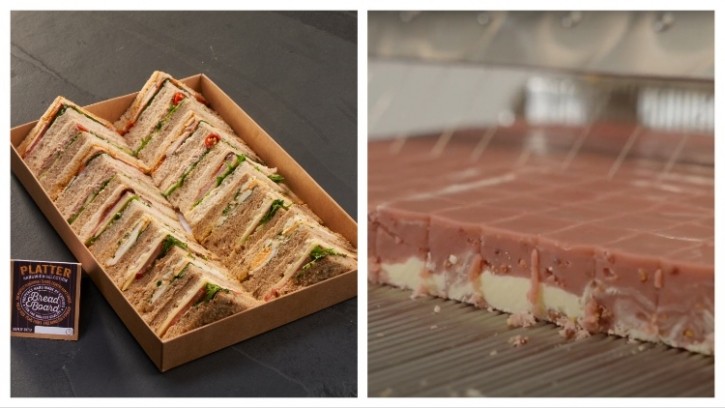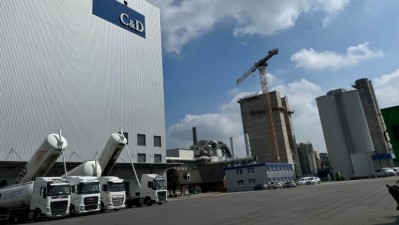Feature
Slicing simplified: from knife to ultrasonic waves

Honestly Tasty
Site address: Rear Entrance, Library Mall Parkland Road N22 6ST
Number of employees at site: 11
Main products made at site: Plant based alternatives to brie, camembert, blue cheese, and garlic and herb spreads
Size of site: 5,000 sqft
Investment into cutting machines: c.£40-£50k including tooling
Year cutting machine was bought: Initial kit in 2021; subsequent tools in 2022
The London alternative cheese manufacturer, Honestly Tasty, was set up in 2018 after its co-founder, Mike Moore, couldn’t find a vegan cheese he liked.
“I went vegan about 7 years ago and I just expected there'd be cheese alternatives out there, but there wasn't. So I started designing them,” Moore recalled.
The business started in a residential kitchen, just supplying independents, with his sister coming on board as a co-founder.
Like a lot of start-ups and smaller companies, Honestly Tasty launched an online shop and the siblings did everything from producing, to cutting, to packaging and shipping.
After six months, the duo moved into a very small commercial kitchen, before finding its current home in November 2021.
Since then, the brand has secured several listings, including Planet Organic, Selfridges, and Ocado, alongside work with M&S and Holland & Barrett, with more launches in the pipeline.
Today its London premises hosts a raft of bigger machinery, including its cutting machinery.
“Before we were blending stuff in pots on electric heaters, now we have big mixers which can heat and cool product, big maturation rooms, and a better cutting kit, which is very helpful.”
The early days of cutting for Honestly Tasty were with the humble knife, before moving to stencils so angles could be achieved more smoothly. Still, the process was slow and required an incredibly steady hand.
“Cutting by hand is incredibly hard,” explained Moore, because its tricky to get the weight exactly right. “If you cut a few grams under you’ve basically wasted that amount of cheese because you can’t just smush it back into the wedge! You can also accidentally cut over. Unless you’ve got a really good eye, it’s quite hard to get it precise and right every time.”
Without precise weights, that’s a lot of potentially wasted margin.
“You have to have a safety factor built in because as soon as you lose a piece for being too small, it’s wasted.”
The new premises in 2021 also brought with it the new cutter. In terms of its benefits, this has not only sped up the process, but it alleviates the risk of over and under cutting, as well as offering a uniformity that human cutting can’t compare with.
“It’s nice to have that conformity,” Moore added.
Describing the machine, he said: “It’s basically a set of cheese wires, cross sectioning one another.”
Essentially, once the cheese is placed onto the platform, a lever is pulled to centre it. There are two buttons – which is a safety feature to avoid fingers and limbs from going near the machine, with additional fencing around it, for further protection.
“As soon as you’ve shown someone how to use it once or twice, it’s very, very easy. The main thing is the centring arm.”
The machine is also very straightforward to clean – with the various parts taken off and wiped down and sanitised.
“Because everything we use – all the plant-based cheese – has a fairly low melting point, it’s not too hard [to clean].
“It’s very straightforward, there’s no intricate parts that we need to dissemble.”
The machine is cleaned at the end of every day and if left for a longer break, it’ll be cleaned then too. White moulded cheeses are cut first, with any blue cheese saved for last to avoid cross contamination. The room will then be left overnight for the air to purify for the next day.
Once triggered, the cutters come down and divide the product into 18 pieces for its cheese wheels and 16 pieces for its brie.
“The machine can do different cuts, but you need to buy tooling sets,” explained Moore. This includes the cutter and the platform, which has slots that the ‘cheese wires’ slide into.
Moore said the business hasn’t seen much interest in different cheese sizes, with most of its innovation embedded within packaging and shelf life, as well as flavours.
However, he did note that the European market is moving more towards slices – likely to be a trend of convenience.
Whilst Honestly Tasty can’t offer slices without getting more kit involved, Moore says the machinery it has is “decent”.
“Obviously, I’d love a machine that could do every single thing in the world, but it’s a really solid piece of kit.
“The size of our premises is limiting – we wouldn’t actually be able to fit new kits in there, so we we’d have to go into a larger premises. I have a wish list of machines that I would love to get on site, which would allow us to do everything from grating to cubing, everything under the sun. But at the moment, we’re just working on product development.”
Baker & Baker
Site address: Baker & Baker Bradford, 200 Cutler Heights Lane, Bradford, BD4 9HY
Capacity of the cutters: 3.5 tonnes an hour (if all cutters are running)
Number of employees at site: 360
Main products made at site: Flapjacks, brownie, cookies, shortbread, chocolate clusters, rocky road
Size of site: 13,000 sqm
Investment into cutting machines: £2.4m
Year cutting machine was bought: 2018
When Kevin Barnes, plant manager for Bradford, started his career at Baker & Baker in 2013, the city was home two of its sites.
The following year, the facilities at Spencer Road and Wakefield Road merged, moving into a new base situated at Culter Heights Lane, with Barnes taking on his current role as plant manager.
“When I first joined, a lot of what we did in Bradford was very labour intensive and hand operated,” Barnes recalled. “We actually use to hand deposit the flapjacks and hand count all our mini bites into acetates.”
Similarly, the cutting of its bakery products has had a big update. Previously, after being baked, the so-called ‘slabs’ of product would be cut using a static cutter blade. This required three operators, who had to feed in and cut the slabs manually on boards.
Today, the factory produces circa 11,000 tonnes of product a year, making 242 SKUs a week, including mini bites (brownies, flapjacks, cookies, shortbread) as well as chocolate clusters and rocky road.
“Around 2015/16, there was a lot of talk in the UK about labour rates increasing. At the time, we had around 600 people here. If we hadn’t done anything in terms of optimising, like we did, it would have cost Baker & Baker £3m a year more annually to run Bradford.”
And with labour increases having since risen further, the cost of inefficiency would have been eyewatering.
“So we decided to look at ways of automating,” Barnes said.
Long gone are the days of hand depositing flapjacks and manual cutting, today the site uses a range of machines to help with that.
For cutting specifically, Baker & Baker has found ultrasonic technology to be a firm favourite – and one which removes the qualms of blunting blades and constant cleaning.
Whilst any keen chef will know that cutting with a sharp blade is best (and safer), the ultrasonic blade doesn’t need a fine edge. In fact, it’s not the stainless-steel blade that’s cutting the product at all, it’s soundwaves.
Each sonic cutter has an oscillator attached to it and this creates a frequency so high, it can slice through even harder sweet treats like blondies.
“The ultrasonic waves give a really clean cut. The blade is really just a carrier for the sound waves,” Barnes explained.
Bradford is home to four of these ultrasonic cutters – cutter five and two for its higher volume SKUs and cutters four and four b for its lower volumes.
Cutter five comprises four index robots and two lines of two. As Barnes elaborated, this means that as long as it’s the same product going down the line, you can run two different programmes (cutting different sizes) simultaneously, or run half the line if the entire one isn’t needed.
Cutter four has a single robot arm and cutter four b a double one. The technology is also fully programmable, so it can cut a variety of sizes.
The operation of the machine does require training but it’s a fairly simplistic piece of kit to use, Barnes told Food Manufacture.
The more technical aspects of it come with the programming and intricacy of the machine – a role for Baker & Baker’s team of multi-skilled engineers.
“We took them through a really in-depth programme about how the oscillators work, where they’re situated, how you replace them, what happens if you get a chipped blade and the software side too.”
The engineers are responsible for programming in the settings – for example, if one customer wanted a particular size of cut, that is programmed in and saved under a specific code. The operator can then insert that code for the right end result.
“I've been in the food industry for 30 years plus and I'm a big believer in taking proven technology and making it as simple as possible for the shop floor colleague,” Barnes said, adding that this not only makes life easier for the workers but also minimises the risk of error.
Since it’s rollout at Bradford, the cutters have all had software updates with a wider band of frequencies added, which means they can cut a more diverse range of products. They have also become simpler to install and smaller, Barnes noted.
Cutters five and four b have also had blade upgrades – with the material changed to offer improved oscillation.
While the ultrasonic blades can cut through most things, Barnes assured they’re “extremely safe”, with the cutting section full guarded with inter-locks. The feed into the cutter is fully controlled, the operator loads the ‘slab’ onto the in-feed belt and the cutter does everything else.
“I've been working with these pieces of kit for 11 years and we've have had no incident whatsoever from them.”
A key safety mechanism is its maglock system – with six keys required to unlock the guards on the machine to clean it.
The cleaning of the system is very simple too, according to Barnes, with the operator using a food hygiene wipe to swiftly but thoroughly clean the blade. As they are visible, it also means the blades are easy to inspect.
“Because of the success we've had here in Bradford with ultrasonics, our sister plant in Daventry has also invested in ultrasonic technology to cut their flapjack and brownies!
“Baker & Baker are very good in terms of investing into their facilities.”
Indeed, the cutters and packaging lines at Bradford have both seen big ‘injections’, with the Bradford site seeing a new robotic picking/packing line for cookies and shortbread introduced just last year.
Raynor Foods
Site address: Farrow Road, Widford Industrial Estate, Chelmsford, Essex CM1 3TH
Capacity and output of site: 200,000 items per day
Number of employees at site: 320
Main products made at site: Sandwiches, wraps, salads and rolls
Size of site: Main factory – 2300m2 and Free-from site 350m2
Investment into cutting machines: £2.4m
Year cutting machine was bought: First ultrasonic cutter in 2013 and a second in 2014, and automatic slicer and manual slicers both in 2022.
Since Raynor Foods first started trade more than 35 years ago, it has been slicing and cutting all manners of ingredients – from slicing tomatoes to dicing onions, or simply cutting a sandwich in half.
As with the other manufacturers, these methods have not changed significantly – tomatoes are still sliced, wraps still cut – but the level of automation certainly has.
Like Baker & Baker, Raynor Foods uses a sonic cutter.
“This is a fantastic bit of technology that effectively creates a sonic edge a millimetre in front of the blade, thus all the sandwiches we produced are cut with sound!” Explained Tom Hollands, innovation and technical director of Raynor Foods.
“This allows us to accurately cut the sandwiches with any filling, even more challenging ones such as bacon. Accurately cutting the sandwich is also important in ensuring the nutritional and carbon emissions displayed on the pack are accurate, especially if you are making any claims such as high levels of protein.”
The company has heavily invested into its cutting machines, with the sonic technology being particularly pricey due to the blades being made with honeycombed titanium.
But it also has other machines, such as automatic ham slicers, robot coupes, blizers, which drive efficiency and accuracy when it comes to prepping the sandwiches.
“There are a whole host of benefits from utilising this [kind of] technology, obviously speed, throughput and quality are some aspects, but also hygienic design and operator safety being important considerations as well,” added Hollands.
Some of the machines do have the flexibility to get creative with the cuts, for example some, such as the robot couple, have different attachments. This can slice, grate and chop against various formats. Whereas others in the factory are more limited to just slicing vegetables and certain meats.
“In sandwiches, trends and fashions are more usually expressed through bread types, rather than shapes,” commented Patrick Jackson, Raynor Food’s product development manager and previous FMEA future talent winner. “The industry’s requirement for easily processable carriers enforces the need to stick to standard formats for the bulk of food to go.
“That said, we are constantly researching new carrier types outside sandwiches – variations of wraps, rolls, bagels, ciabattas, etc. New cuisines and taste concepts are always being created, and these often come with a distinctive carrier of some kind, often related to the ethnicity of the food. Our challenge is to reproduce the essence of these ideas and express them in a manufacturing context to provide our customers with fresh retail thinking.”
Whilst Raynor Foods is exploring NPD in the background, for its current machines and processes, Hollands said training is vital.
“Training is absolutely critical for any operator carrying out a slicing or dicing action, from basic blade work to more complex machinery such as ham slicers. PPE is often required, such as chain mail gloves, especially when breaking down the machine to clean,” he explained.
“Typically, there are motherboards within the equipment with a host of sensors, this means cleaning has to be carefully carried out and operators must be trained on how to use the machinery and get the very best out of them.
“Some machinery is more automated than others, a good example are manual slicers (like you see in the Deli when slicing a portion of ham) to fully automated slicers which you feed in logs of ham at the top and sliced ham exits out on a conveyer.
“Preventative maintenance is essentially when using any piece of kit, from both a health and safety perspective but also food safety. If machines are not regularly maintained, then they can also create quality problems and worst case fully break down which can create significant disruption to manufacturing.”
Fudge Kitchen
Site address: Fudge Kitchen, Aylesham Industrial Estate, Unit 1 Cooting Rd, Aylesham, Canterbury CT3 3EP
Capacity and output of site: 300 kilos of fudge per day. Use the cutting machine to process 11,000 pieces of fudge miniatures per day.
Number of employees at site: 17
Main products made at site: Handmade artisan fudge for luxury gifting at the site, such as its gift selection boxes and the products supplying luxury hotels/department stores.
Size of site: 5,500 square foot
Investment into cutting machines: £6k
Year cutting machine was bought: 2014
Arianne Langham is the site manager for Fudge Kitchen, based in Aylesham, Kent. She’s been with the company just shy of 20 years, having started out in the Canterbury shop, part time during her A-Levels.
In 2012, the then MD, Sian Holt, set up the business’s first production facility in Aylesham.
“She asked if I wanted to come along for the ride. I’d just graduated [from university] and I lived in the village anyway – so I thought, why not?”
Langham had originally intended to take a gap year before going back to her studies, with ambitions of becoming an art teacher.
“And I’m still here!” she laughed, adding that the company is “a creative bunch”, so it still allows her to enjoy that artistic side.
The creativity in fudge arguably lies in the flavour and decoration, which is all done by hand, but cutting remains a pivotal part of the process.
Like the toppings, cutting was once done by hand, with each slab of fudge scored and then segmented with a knife.
“It was really labour intensive. So when we found this piece of machinery, after being here for about 2-3 years, it was the best day ever. We haven’t looked back, it has really changed our world.”
The cutting team usually manage to cut around 30 batches of fudge between 5 and 6 hours.
“To cut 30 batches by hand – it would probably take 20 hours.”
Langham recalled the earlier days, saying it had been a big learning curve because the company just hadn’t been aware of the machinery out there.
“We landed this site not knowing a thing because we came from fudge shops – we were retailers – we didn’t know anything about manufacturing and we’ve learnt along the way.”
The ‘life-changing’ machine is an electric guitar cutter – essentially a moving bed that brings the product (in this case fudge) towards a series of cheese wires.
Whilst you can get handheld guitar cutters, Fudge Kitchen’s machine is electric, with a button that triggers the platform to move forward and back.
Although the machine has simplified things, it’s still a fairly manual task requiring a team of four.
The cutter comes in one size, so one team member is responsible for cutting the slabs – which have been left overnight to set – in half, so each it fits the platform. Another team member will place the halved slabs onto the platform, lining it up with the cutters.
The team member responsible for placing it onto the platform doesn’t have any official guidelines for where to position it, with Langham saying it’s all about experience.
“There are no guides on there but there’s these little teeth which are on the beds. I usually just count 5 teeth which is about the right place. That will only come from product experience.
Once they have pressed the button and the fudge is cut, they’ll pop the slab back onto a tray, click the button again to retrieve the platform, and pop the slab on the other way. The button is clicked again and the fudge is cut again to make a neat square.
“It obviously requires a little bit of training, but nowhere near as much training or finesse as hand cutting.”
As the cutters work their magic, the edges will be trimmed by one of the wires to make the pieces uniform. This waste and any crumbs left over are then melted and put into other batches. The only exception to this are the ‘zingy’ flavoured fudges – lemon sherbet, rhubarb and custard – because they contain malic acid which does not respond well to reheating.
“Everything else can go back in the pot and be melted down.”
The other two team members then focus on separating the fudge. Due to its sticky nature, the segments need to be gently pulled apart to enable air to flow between each side so the fudge sets properly.
“Four [individuals] is the perfect number, it keeps it all moving,” Langham added.
This same team will then hand decorate all the individual squares, this could be a chocolate finish done with piping bags or edible dusting, for example, and takes the team a couple of hours.
Like Honestly Tasty, the Fudge Kitchen has an array of different shaped and sized cutters, which offer modest flexibility.
“You can't cut round things. It needs to be a square, but it could be any size of square or rectangle.”
In terms of shapes and sizes, Langham said Fudge Kitchen keeps it simple – cutting two size formats – miniatures and fudge bites The latter are four times the size but half in depth of the minis, and go into presentation boxes for hotels.
The machine is fairly easy to clean, with the parts detaching and going through a wash and sanitation process at the end of the shift.
“We just clean it at the end of every day, leave it to air dry and it's good to go the next morning. The team can put it back together in 2-3 minutes.”
Again, similar to Honestly Tasty, the schedule for what runs through the cutters first is important. Fudge Kitchen begins with the plain fudges, such as clotted cream and salted caramel, then moves onto the fruits like raspberry, then the chocolate fudges and then at the very end of the day, the nutty ones. This helps avoid cross contamination of colour and strong flavours.
As Fudge Kitchen has progressed in its journey from fudge shop to manufacturer, Langham said the team has learnt some valuable lessons – not just in the scope of machinery out there but also in the importance of having a back-up.
Just like the strings of a guitar, the wires of the cutter can sometimes snap – and although it’s a rare event, it has happened.
“They’re good till they go. If you’ve got a slightly hard batch of fudge, which possibly happens 2-3 times a year, perhaps the temperature went higher than we thought, you’ll put it through the cutters and the wires will just go ping.”
The first time the wires broke, the team had no choice but to revert to hand cutting. Shortly thereafter, a second machine was bought.
If the wires do break, new ones must be threaded in, which, according to Langham, is a fine art and takes even their trained team members half an hour.
The spare machine means the team can crack on whilst the other is re-stringed.
It may not sound like the perfect system, but the team have it down to an artform today and for its current output and space, Langham says the machine is perfect.
“I think for us and the amount that we're producing at the minute, the machinery that we've got is absolutely fine. But if we were ever to in the future, turn into a 24-hour manufacturing site, we’d have to look again. And we’d probably need a bigger site!”




















